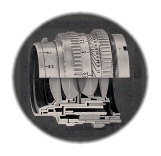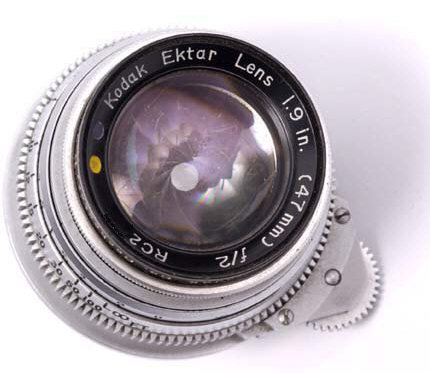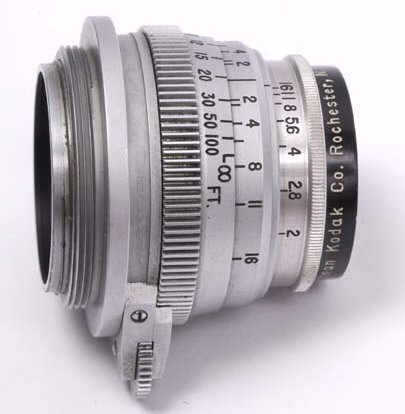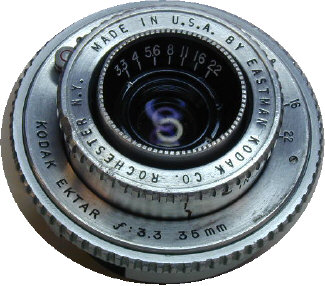|
Unauthenticated
Anomalies - The Lykemar
The Lykemar is intriguing, partly
because of the mystery of its obsurity. Bert
Furnari offered this lens in an eBay auction and based on the limited
information he could find in print and from other experienced dealers,
he conjectured that the lens might have been manufactured by Kodak. We
discussed several issues, from which we could draw no definite conclusion.
- The lens is described in HPR
Leica Copies, as manufactured by Kodak. Bert wondered if that included
Kodak making both the optics and the mount. The front element does have
a serial number
 that is consistent with Kodak production.
that is consistent with Kodak production.
- To me this does not look like
a Kodak mount. Even Kodak prototypes had a very finished appearance,
for example like the prototype 80mm collapsible Ektar
 .
The Lykemar's finish has more machining marks, though Bert says that
its focusing action is smooth. .
The Lykemar's finish has more machining marks, though Bert says that
its focusing action is smooth.
- The Lykemar does not look much
like the f /2 Ektar for the Kardon, whose general design is more
like the Ektra's f /1.9 Ektar
 .
A 35mm or 85/90mm lens would have been a natural choice if Precision
Instrument were planning an additional offering. The Kardon camera looked
like a Leica because Kardon took Leica parts and assembled them, but
the company took no pains to make the Kardon lens look like a Leitz
lens. The designer of the Lykemar obviously did. [When
did Leitz start making the Summaron? Can't find a picture of one, though
one old Leica book says they were rigid rather than collapsible] .
A 35mm or 85/90mm lens would have been a natural choice if Precision
Instrument were planning an additional offering. The Kardon camera looked
like a Leica because Kardon took Leica parts and assembled them, but
the company took no pains to make the Kardon lens look like a Leitz
lens. The designer of the Lykemar obviously did. [When
did Leitz start making the Summaron? Can't find a picture of one, though
one old Leica book says they were rigid rather than collapsible]
- Kodak introduced the Ektra in
1941, but it had been in design at least as early as mid-1938 according
to patent records. Its price and complexity made it one of Kodak's war
casualties. The pattern of inclusion or lack of it in early post-war
Kodak literature suggests that Kodak was not pursuing the precision
35mm market after the war, though it would have seemed that Kodak would
have had a major market advantage. Looking at changes in Kodak product
lines from roughly 1946 through 1948, suggests that Kodak's wartime
experience was guiding it away from precision consumer cameras and toward
mass market entry level small and medium format and affordable minatures,
studio cameras and optics, photo materials and their industrial chemical
lines.
- Bert hypothesizes that Kodak
might have wanted to get a piece of the Leica/Canon lens market. While
such discussions were possible at Kodak, this seems unlike the proud
producer of the Ektra or the Medalist which borrowed little from the
design of existing competitors.
- Kodak had shown no apprehension
about supplying lenses for the manufacturers of other cameras. Graflex,
a part of Kodak until the 1920s, had used Kodak lenses for decades.
Kodak supplied Ektars for the first Hasselblad's, and during the mid-40s
had supplied at least the optics for the Kardon, potentially competition
for the Ektra, though a feature comparison pulls the Leica design up
very short.
- I think the more likely explanation
of Kodak's role in the Lykemar was that Kodak no longer had any concern
about competition for the Ektra after the war and either sold existing
inventory of lens elements or produced a relatively small batch of them
for a small manufacturer who wanted to take advantage of the disarray
of the German and Japanese camera industries by starting up the American
production of Leica screw mount lenses.
- In any case, if this is one of
the Ektar Heliars, it is one of the best designs created during Kodak's
Golden Age. In this mounting it would also be one of the rarest.
|




